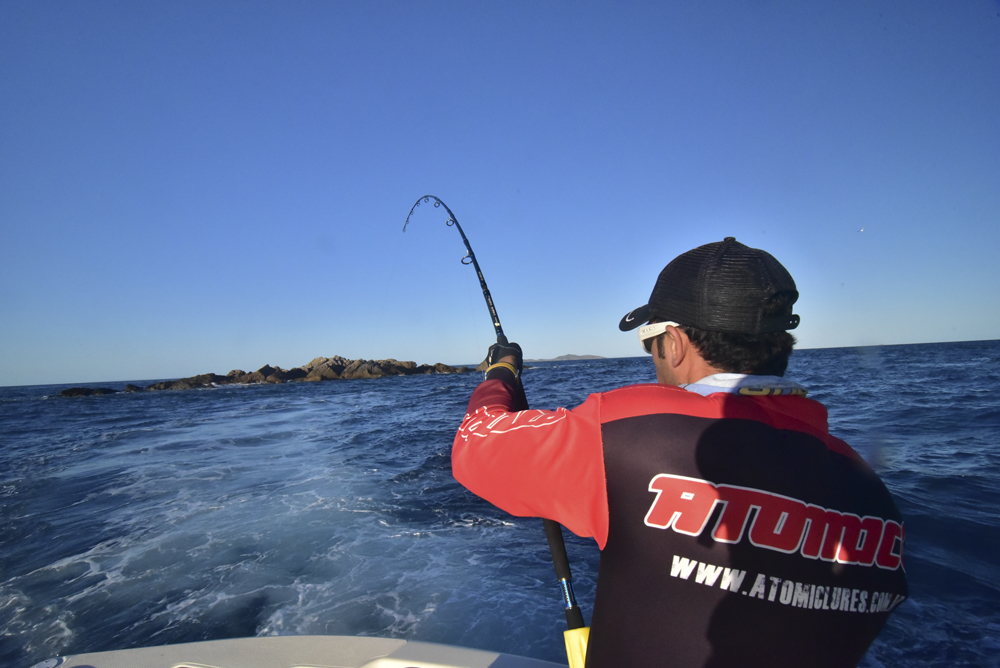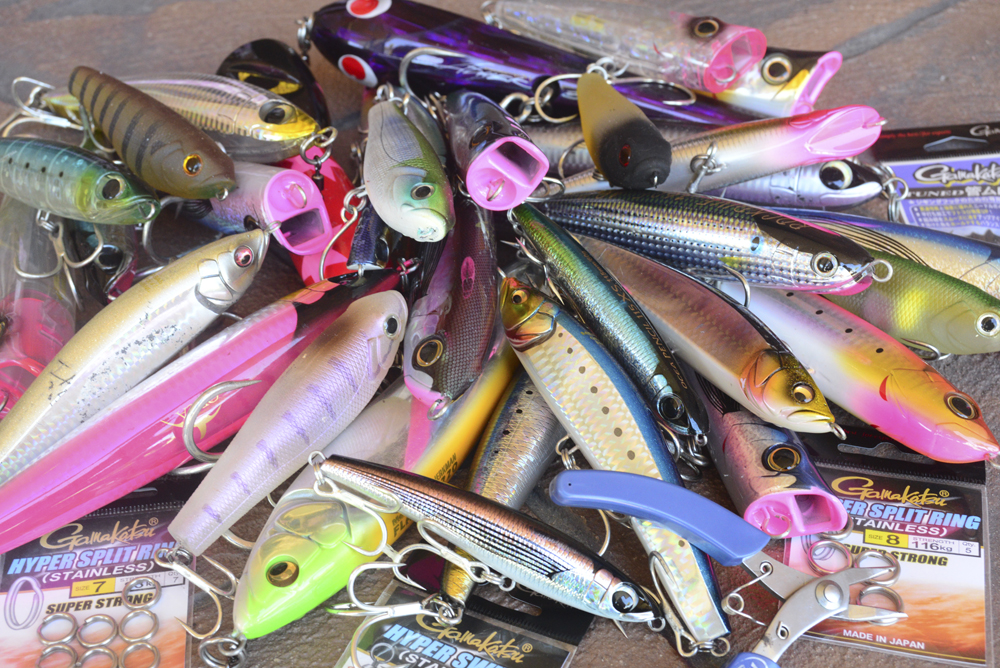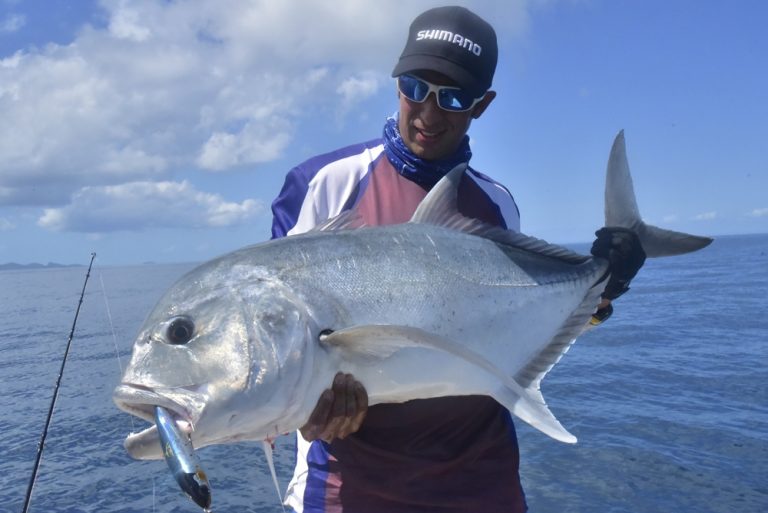Pop Till You Drop – By Luke Galea
There is a fine line between pleasure and pain, and throwing big poppers and stickbaits for giant trevally yields plenty of both.
Despite the pain we inflict upon ourselves, we always go back for more, often looking for the next size class of fish to really test ourselves and our gear to the limits. These fish are tackle destroying machines, and their power is truly unbelievable. For me, these fish get the heart racing like no other.
I’ll be honest straight up and state that I am not a dedicated GT specialist by any means. There are just far too many fishing options in Mackay for me to be. There are plenty of blokes who have caught plenty more of these things than me so please don’t think I’m proclaiming to be some kind of overnight expert on these things. What I will also say, however, is that I have caught a few dozen now and have well and truly picked up on a few things which I’d like to share, particularly with those contemplating having a crack at these fish for the first time.

Most people with a reasonable tinnie and strong sense of adventure are in the fray to lock horns with one of these beasts. By way of ocean-going craft, obviously large glass boats have the weight and fuel capacity to push further afield than the standard vessel, but those with an open boat or centre console over 4.5m are in with a shot at the closer grounds, particularly those around inshore islands. Centre consoles are ideal as these fish will often run you round every inch of your boat before they succumb to the battle. A decent casting deck is also a necessity as room to move, and angler safety is imperative when you’re swinging large, heavy lures with oversize hooks.
Although we have caught quite a few smaller GT’s on reef edges, drop-offs and flats, we have caught fewer but larger GT’s from isolated pinnacles and sea mounts located further off the reef in deep water. These fish need to be raised with the loudest, largest, cup-faced poppers that snap the water with each ‘bloop’. These lures need to be ripped hard, which can be really taxing on the body. We have found darker coloured lures to perform better whilst popping over deep water. Purple, black and dark blue coloured lures have yielded the best results and may be due to a similar concept as using dark lures at night. They simply silhouette better whilst looking up from the depth against a lighter backdrop.

Promising looking GT water is not overly hard to find. A good place to start is by interrogating the C-MAPS charts that come built into most decent sounders. These charts provide great detail over extensive areas, and it pays to identify a few likely locations at home with your mates (beer in hand of course) before embarking on your GT mission. Simply look for contour lines stacked closely together, rising up out of deeper water toward a peak. This sort of structure will attract marine life from far and wide often, including prolific schools of baitfish and of-course, predators. Most of the time, this structure is the only structure for miles, so it goes without saying that it stands out like a supermarket in the middle of the desert. The structure may not necessarily break the surface of the water but fierce eddies and current lines will be visible, and this is what you need to look for. Baitfish swim around rather disorientated whilst in these zones, and this is where the large predators take full advantage. Fusiliers often ball together in these zones and are one of a GT’s favourite things to eat. Garfish and long tom would have to be a close second. In fact, we have even had GT’s eat small mackerel (around 60cm) we had unintentionally hooked as well. This tells me that there is no lure too big for a GT to consume.
Another sure-fire way to find prominent GT territory is to simply drive around any offshore island or island chain checking out the prominent points. All islands exhibit a multitude of different habitat environments. Whilst some will have deep edges, cliff faces, canyons or shallower shelfs, all of them will have rocky points that will generate current and pressure points at different stages of the tide. We find that it doesn’t really matter if the tide is incoming or outgoing, as long as there is a decent flow in either direction, the fish will be there. Just make sure you fish the pressure face of the structure. Things are usually pretty quiet during the slack water associated with the top or bottom of the tide.

As mentioned above, fast flowing water is a key-criteria for finding GT’s. We all know that the full moon and new moon each month generate the largest tides; however, we have found the new moon (or dark moon) to produce far more actively feeding fish than the full moon. In fact, locally anyway, I would go as far to say that that the bite on the large tides associated with the full moon has been rather slow. From what I have read online and in fishing forums, the theory for this is that GT’s will feed on prey throughout the day as well as the night on the full moon as there is enough light for them to do so. On the dark moon or new moon, the fish gorge themselves and feed far more actively throughout the day as the dark night does not allow enough light for them to sight feed. We have had some insane surface sessions on the tides associated with the new moon.
Landing a GT is a team effort. Given the ripping eddies and currents, there needs to be a full-time boat driver, and they need to have their wits about them. One or two people should be positioned on the casting deck firing out long-range casts, preferably one casting right handed and the other left-handed. When an angler hooks a GT, this angler should give their rod 3 or 4 sharp rips to help set the oversized hooks. Whilst this is happening, the driver should be reversing the boat away from the structure to give the angler the best chance at stopping the fish from bricking them in the reef during one of their powerful surges. They certainly know where the reef is. Whilst this is all happening, the second angler should be retrieving their lure as quickly as possible and putting on a glove so they can wrap one hand around the tail wrist of their mates fish. The tail wrist contains extremely sharp scutes.
If you are going to start targeting GT’s, then you are going to need to invest in a strong yet lightweight graphite rod and heavy-duty spin reel with a smooth, powerful drag. There is no place for cheap, second rate gear when targeting these beasts so you will need to outlay a bit of money to get something capable. $1,000 would be the minimum required but spending up to $2,000 or even $2,500 is not uncommon amongst the die-hard anglers. $1,000 is a lot of money, but considering some anglers spend more than this on a combo to chase bream, then I think its well and truly an awesome investment considering the stature of these fish. A good popping rod will be between 7 feet and 9 feet long and be weighted around PE6-10 (60-100lb). I use a Samurai X-Tracta XT-POP100. These rods retail for just over $500, which is good value for such a quality rod. It’s fair to say there are far more specialised, high-end popping rods on the market, but I have found this rod to be excellent and does everything I’ve ever needed it to do.

For the occasional GT angler like myself, the Saragosa is a very reliable and capable reel, and at a price point nearly everyone can afford. A Saragosa is a relative entry level and would be the minimum quality reel I’d recommend. For those dedicated GT anglers who target them more frequently, well there is no substitute for Shimano Stella’s in sizes between 14,000 and 20,000. These reels are the cream of the crop when it comes to high-end spin reels and are more capable of handling the abuse dished out by these fish. Whatever reel you decide on, make sure it has a high-speed ratio so you can gather more line back on the spool with every wind of the handle. Like rugby league, GT popping can sometimes be a matter of inches, ie inches between victory and these fish wiping you out on the reef. Don’t skimp on braid either. A good quality braid can be expensive, but there is no point dishing out the coin for a quality combo only to have an inferior braid let you down. I would recommend using a minimum braid weight of 80-100lb and a good quality fluorocarbon leader of between 150lb and 200lb. A good 10 feet of leader material is recommended and gives the angler a little more peace of mind when fighting these fish. It should be noted that that the longer the leader is, the shorter the cast will be as a longer leader does tend to inhibit casting distance. Your braid and leader should be connected with an FG knot or similar slimline knot.
I’m not going to delve into the weird and wonderful world of lures in too great a detail. There truly is a multitude of different options in every size, shape and colour under the sun and can range from as little as $30 up to a couple of hundred for a single lure. This is crazy. GT fishing is brutal. You can, and often do get bricked on regular occasions, so the dollars can quickly add up. Just make sure you cover your bases by way of poppers, stickbaits and sinking stickbaits. When fish are shy, we have found that sinking stickbaits work a treat, but you give up the ability to view your lures being inhaled off the top which is a big part of the appeal in my opinion. My mates and I like to work in tandem to raise and hook the fish. One of us will often cast out a loud, blooping popper and raise the fish whilst the other angler fires in a stickbait a few metres behind. The popper will attract the fish with its loud action, but the fish will often grab the trailing stickbait out the back. My stickbaits of choice are those from the Shimano Ocea range which we usually retrofit Gamakatsu single hooks and split rings to. We find the hookup rate with singles to be far superior to that of trebles.
Popping/stickbaiting for GT’s is hard work as these fish will test angler and equipment to the brink. Busted leaders, pulled split rings and broken lures are all in a days work, but it is the reason why we keep coming back again and again. The pain is real, but once your mate wraps his hand around the tail wrist of your fish, the feeling is hard to beat. Give it a crack.





